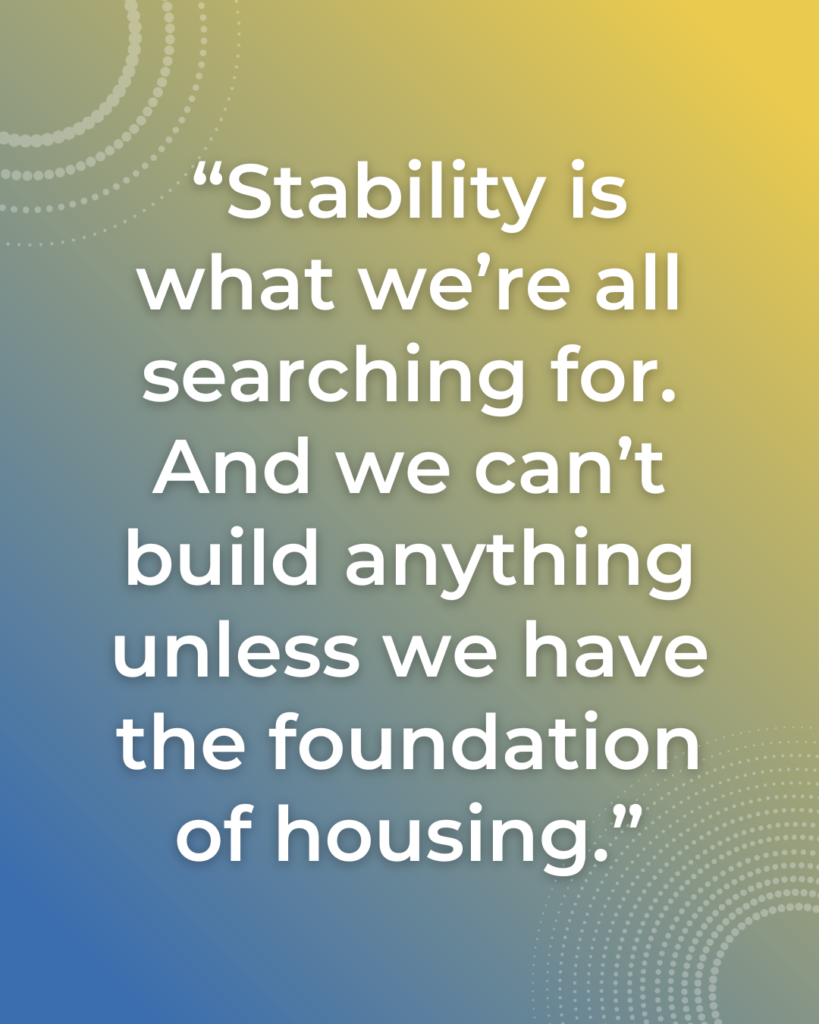


Housing Narrative Lab Year-End Narrative Spotlight Awards
12/05/2024

What does it take to change a big narrative? It takes many stories, shared consistently over time, that reach broad audiences. That is how we begin to shape people’s understanding of big social problems like homelessness and unstable housing, and what we can do to solve them.
This year, our Housing Narrative Awards spotlight stories about homelessness that reach strategic audiences, use creative storytelling or help explain the depth and complexity of the issue so more people are open to proven solutions. The films, news story, op-ed, social media post and podcast below represent a wide range of approaches to storytelling about what causes homelessness and housing insecurity, who is affected and what we can do about it.
OUR PICKS
Documentary Film: “Beyond the Bridge: A Solution to Homelessness”
“Beyond the Bridge: A Solution to Homelessness” shows what is possible when everyone – from people with lived experience, advocates and service providers to police, the courts, business leaders and government officials – work together to provide housing and services that people need to thrive.
The film is at the center of an impact campaign to build support for housing first solutions. By sharing this powerful story about proven solutions at in-person screenings and hosting discussions with community members and officials, the film is helping to advance real housing first policies at the local level.
Narrative Film: “The Beautiful Game”
Based on the real-life Homeless World Cup, the film features characters who find belonging through sport amidst the challenges of homelessness caused by war, a rigged housing system, eviction, addiction and many other causes of homelessness. “The Beautiful Game” shows that community and belonging are a central part of enduring and solving homelessness. This film uses asset-framing and explores the many reasons people face homelessness, bringing accurate stories to a big, general audience (people who are not working to solve homelessness).
Op-Ed: Michael Ruggles, Op-Ed in the Barre Montpelier Times Argus.
Michael Ruggles’s op-ed in the Barre Montpelier Times Argus uses his personal story to show that solving homelessness is possible. Vermont has a rapidly rising number of people experiencing homelessness and Michael was able to be housed using a housing-first approach because he is a veteran. His story powerfully weaves his personal experience with what’s possible if decisionmakers follow best practices.
“My story is one of many that show this problem is solvable. Homelessness among veterans has decreased almost every year over the last decade even as it has soared both nationally and in Vermont. This is because the U.S. has committed to Housing First for veterans.
“Housing First isn’t available for everyone who needs it though. There are a lot of people in the Northeast Kingdom who are homeless but not veterans. I left many people behind in the motel when I found housing. Some have now lost their motel room and have returned to the street. Others are living by the river. Some are still in the motel, but they still can’t find a place to go.
“Stability is what we’re all searching for. And we can’t build anything unless we have the foundation of housing.”
Social Media Storytelling: Damion Scott, “Why Can’t Everyone in the Bay Area Have a Home?” on TikTok
Damion Scott’s TikTok video “Why Can’t Everyone in the Bay Area Have a Home” uses humor and playful character acting to highlight what’s standing in the way of solutions to homelessness and unaffordable housing.
Damion Scott is the Lead Organizer at East Bay Housing Organizations and the video is part of the Begins with Home campaign. The video invites people to address local housing issues by “rewriting the rules” in the Bay Area.
Reported Story: Florida Criminalized Homelessness. Then Came Hurricanes Helene and Milton Rachel M. Cohen, Vox
What happens when climate disasters like hurricanes strike communities that choose to ticket, fine and arrest people who have nowhere else to live but outside?
“These dynamics have grown more pressing as major hurricanes increase in frequency and the number of unsheltered Americans continues to grow. In June the US Supreme Court issued a landmark decision in Grants Pass v. Johnson, greenlighting local governments’ legal authority to clear out homeless tent encampments even if a city lacks any available housing or shelter for the unhoused person to stay in.”
The article examines how climate disasters combined with local efforts to arrest, ticket and fine unhoused people makes life outside even more dangerous for people who experience homelessness. The article explores the complex and unresolved policy intersections of climate disaster and homelessness.
Podcast Episode: “Fighting Family Homelessness” on No One is Coming to Save Us by Lemonada Media.
“No One is Coming to Save Us” host Gloria Riviera connects a strategically important audience – mostly middle-class parents – to a deep explanation of the structural causes of family homelessness through an interview with Kate Barrand, who runs Horizons for Homeless Children in Boston. She then interviews Caitlin Liversidge, a new mother in San Francisco who found herself unhoused and pregnant last summer, about what it took for her to make it through pregnancy and find stability.
As we wrap up 2024 and reflect on how we can advance a strong narrative – that everyone needs a safe, affordable and accessible place to live — we hope the Housing Narrative Lab Spotlight Awards inspire your plans to create powerful stories that change hearts and minds.
1828 L St. NW
Suite 300
Washington, DC 20036
© Copyright 2026 Privacy Policy





